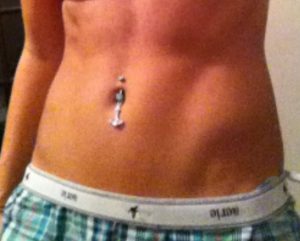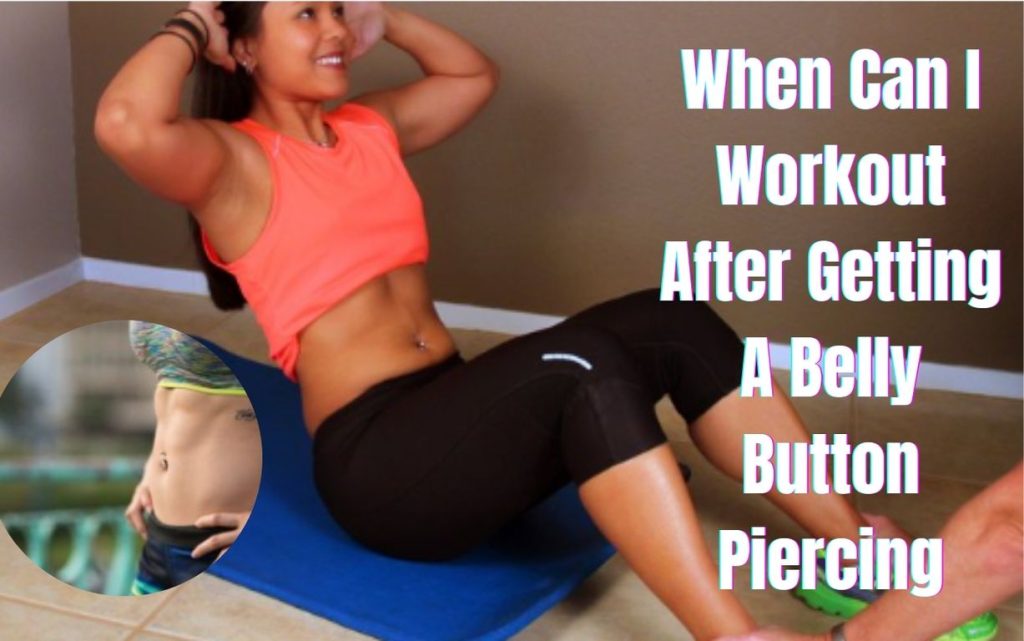After getting a belly button piercing, it’s crucial to prioritize healing before hitting the gym. Typically, you should wait at least 4-6 weeks before resuming intense workouts.
During this period, your body is mending and forming a protective barrier around the piercing. Sweating, friction, and excess movement can irritate the piercing and increase the risk of infection.
Start with light exercises that don’t strain your abdominal muscles or put pressure on the piercing site. Listen to your body and avoid activities that cause discomfort.
Always clean the piercing as recommended by your piercer and avoid exposing it to dirty gym equipment or pools. Consult with your piercer or a healthcare professional for personalized advice based on your healing progress.
Prioritize your health and the healing process to ensure a successful and complication-free piercing experience.
When Can I Workout After A Belly Button Piercing
After getting a belly button piercing, it’s crucial to wait before hitting the gym. You should avoid working out for at least a few days, ideally a week.
By the way, can you run with a new belly button piercing? No, after belly button piercing your body needs time to heal, and intense movements can irritate the piercing, leading to discomfort or even infection.
During the initial healing period, focus on gentle activities like walking or light stretching. Sweat and friction from rigorous workouts may hinder the healing process, so it’s essential to be patient and let your body recover.
Once a week has passed, pay attention to how your piercing feels. If there’s any tenderness or redness, give it more time before resuming intense exercises. Always clean the area well after working out to prevent infection.
Remember, everyone’s body heals differently, so listen to yours. If you have any concerns or experience prolonged discomfort, consult with your piercer or a healthcare professional before ramping up your workout routine.
It’s better to be cautious and prioritize your healing over a speedy return to the gym.
Can You Do Ab Workouts With A Belly Button Piercing

After getting a belly button piercing, it’s best to avoid intense ab workouts for a while. During the initial healing period, which typically lasts a few weeks, your piercing is more vulnerable to irritation and movement-related stress.
Engaging in rigorous ab exercises, such as crunches or sit-ups, can increase the risk of complications like pain, swelling, or infection. And if you are health conscious you must know about the pros and cons of belly button piercing.
Instead, focus on low-impact exercises that don’t put direct pressure on the piercing site. Gentle activities like walking or light stretching can help you stay active without compromising the healing process.
As your piercing heals, gradually reintroduce ab exercises, paying attention to any discomfort or signs of irritation.
Always listen to your body and consult with your piercer or a healthcare professional if you have concerns.
Keep the piercing clean and dry, and consider using a breathable covering or a waterproof bandage during workouts to protect the area. Remember, patience is key to ensuring a successful and comfortable healing process for your belly button piercing.
If you are a woman then you must also consider pregnancy with a belly button piercing. Look at our previous article to know A to Z about pregnancy and belly button piercing.
Frequently Asked Questions
Q: When can I start working out after getting a belly button piercing?
A: Wait at least a week before intense workouts after a belly button piercing. Start with gentle activities like walking or light stretching during the initial healing period. Listen to your body, and consult your piercer or a professional if needed.
Q: Can I do light exercises during the healing period?
A: Yes, light exercises like walking or gentle stretching are generally okay during the healing period of a belly button piercing. Avoid intense workouts to prevent irritation. Pay attention to your body and consult with professionals if needed.
Q: What types of exercises should I avoid after a new belly button piercing?
A: Avoid intense ab workouts like crunches or sit-ups during the initial weeks after a belly button piercing. High-impact exercises that put direct pressure on the piercing, such as running or heavy weightlifting, should also be avoided.
For gentle activities to prevent irritation and allow proper healing. Always prioritize your piercing’s well-being over intense physical strain.
Q: How should I protect my piercing while working out?
A: Protect your piercing during workouts by avoiding tight clothing that may rub against it. Consider using a breathable covering or waterproof bandage to shield the area, and clean it afterward.
Q: When will it be safe to resume normal workout routines?
A: Wait at least a week before resuming normal workout routines after a belly button piercing. Listen to your body, ensure the piercing is healing well, and consult professionals if needed.
Q: Can I use tight workout clothing on my belly button piercing?
A: It’s best to avoid tight workout clothing on a healing belly button piercing. The friction and pressure may irritate the area. Choose loose, breathable attire during the initial healing period to promote comfort and prevent complications.
Final Words
So, patience and caution are key when deciding when to resume workouts after a belly button piercing. Waiting at least a week and avoiding intense exercises during the initial healing period is crucial to prevent irritation and complications.
For gentle activities like walking or light stretching before gradually reintroducing more strenuous workouts. Always listen to your body and be mindful of any discomfort or signs of irritation.
It’s essential to prioritize the healing process, keeping the piercing clean and dry, and consulting with professionals if needed.
Balancing your fitness goals with the well-being of your piercing ensures a successful and comfortable recovery, allowing you to enjoy both a healthy workout routine and a stylish belly button piercing in the long run.





